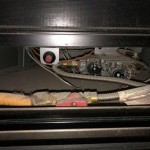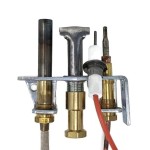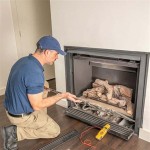Here's an article on painting the inside of a gas fireplace, formatted as requested:
Can I Paint The Inside Of My Gas Fireplace? A Comprehensive Guide
The question of whether or not one can paint the inside of a gas fireplace is a common one among homeowners seeking to refresh or alter the aesthetics of their living space. A gas fireplace, while offering the convenience of instant heat and requiring less maintenance than a traditional wood-burning fireplace, can sometimes appear dated or clash with a new interior design scheme. While painting seems like a straightforward solution, it’s crucial to understand the complexities and potential risks involved before undertaking such a project.
The interior of a gas fireplace is a high-heat environment, and not all paints are designed to withstand such conditions. Furthermore, certain components within the fireplace are critical to its safe and efficient operation, and painting these components could compromise their functionality or even create a safety hazard. This article aims to provide a comprehensive overview of the considerations, precautions, and appropriate methods for painting the inside of a gas fireplace, ensuring a safe and aesthetically pleasing result.
Before even considering paint options, a thorough understanding of the fireplace's construction and the materials used in its interior is paramount. Many gas fireplaces have components made of materials not suitable for painting. Attempting to paint these components could be futile, or worse, detrimental. Always consult the manufacturer's manual for specific information related to the fireplace model in question.
Understanding the Risks and Limitations
The primary concern when painting the inside of a gas fireplace is heat resistance. Standard paints, including latex and oil-based varieties, will not withstand the high temperatures generated by a gas fireplace. These paints can blister, peel, crack, and emit noxious fumes when heated. Furthermore, volatile organic compounds (VOCs) released from improperly chosen paints can pose a significant health risk, especially in an enclosed space. Therefore, the selection of a specific type of paint formulated for high-temperature applications is absolutely critical.
Another potential risk arises from painting components that are essential for the proper functioning of the fireplace. For instance, the burner itself, the gas supply lines, and any safety mechanisms should never be painted. Doing so could obstruct gas flow, interfere with the ignition system, or compromise the safety features designed to prevent gas leaks or explosions. Furthermore, painting the glass front of the fireplace is generally not recommended, as it can affect heat transfer and potentially cause the glass to shatter due to uneven heating.
Certain gas fireplaces feature ceramic fiber logs or panels designed to radiate heat efficiently. Painting these components can significantly reduce their ability to radiate heat, diminishing the fireplace's overall performance. Moreover, the paint could adhere poorly to the ceramic fiber material, resulting in a patchy or uneven finish. Consider the effect on the heat output of the fireplace before considering painting any of the interior components.
Finally, altering the interior of a gas fireplace, even with proper paint, might void the manufacturer's warranty. It is important to meticulously review the warranty terms and conditions before proceeding. Contacting the manufacturer directly to inquire about the impact of painting on the warranty is advisable.
Choosing the Right Paint: High-Temperature Options
If painting is deemed feasible and safe, the selection of an appropriate high-temperature paint is crucial. The most common and suitable option is a high-temperature paint formulated specifically for stoves, grills, and other high-heat applications. These paints are typically available in aerosol cans or as liquid paints that can be applied with a brush or sprayer. They typically have a temperature resistance up to at least 1200 degrees Fahrenheit (650 degrees Celsius), which is generally sufficient for the interior of a gas fireplace.
When selecting a high-temperature paint, it is vital to check the product specifications to ensure that it is compatible with the materials used in the fireplace's interior. Some high-temperature paints are designed specifically for metal surfaces, while others are suitable for ceramic or brick. Choosing a paint that is not compatible with the substrate could result in poor adhesion, premature failure, or even damage to the fireplace components.
Ceramic-based paints are also available for high-temperature applications. These paints offer excellent heat resistance and durability, and they can provide a more aesthetically pleasing finish than some of the more utilitarian high-temperature paints. However, ceramic paints can be more expensive and may require specialized application techniques. Following the manufacturer’s instructions regarding application methods and curing processes is critical to achieve optimal results.
Regardless of the chosen paint type, it is essential to prepare the surface thoroughly before application. This typically involves cleaning the surface to remove any dust, grease, or debris, and lightly sanding it to create a slightly rough texture that will promote better adhesion. Applying a primer specifically designed for high-temperature applications can also enhance the paint's durability and prevent it from peeling or cracking.
Step-by-Step Painting Process: Safety and Application
Before commencing any painting project involving a gas fireplace, safety precautions must be prioritized. The first step is to completely shut off the gas supply to the fireplace. Typically, there is a shut-off valve located near the fireplace, either behind an access panel or in the adjacent room. Ensure the valve is fully closed and that the fireplace is completely cool before proceeding. Disconnecting the electrical supply to the fireplace is also recommended as an extra safety measure.
The next step is to thoroughly clean the interior of the fireplace. Use a vacuum cleaner with a brush attachment to remove any loose dust, dirt, or debris. Then, use a mild detergent and water solution to clean any remaining residue. Be sure to rinse the surface thoroughly with clean water and allow it to dry completely before proceeding. A solvent-based cleaner might be needed to remove stubborn grease or oil residues, always follow the manufacturer's safety precautions when using such solvents.
Masking off any areas that should not be painted is crucial. Use painter's tape and plastic sheeting to protect the surrounding walls, the glass front (if not removed), and any components that are not intended for painting. Ensure that the masking is secure and that there are no gaps or openings through which paint could seep.
When applying the paint, follow the manufacturer's instructions carefully. For aerosol paints, hold the can approximately 10-12 inches from the surface and apply thin, even coats. Avoid applying too much paint in one coat, as this can lead to drips, runs, and uneven drying. Allow each coat to dry completely before applying the next one. Multiple thin coats are generally preferable to one thick coat.
For liquid paints, use a high-quality brush or sprayer to apply the paint evenly. Again, thin coats are preferable. If using a brush, avoid applying too much pressure, as this can leave brush marks in the finish. If using a sprayer, adjust the nozzle to achieve a consistent spray pattern and avoid overspray. Following the paint manufacturer's recommendations regarding the optimal number of coats and drying times is paramount.
Once the painting is complete, allow the paint to dry completely before reassembling the fireplace and restoring the gas and electrical supplies. Refer to the paint manufacturer's instructions for the recommended drying time. Some high-temperature paints require a curing process that involves gradually heating the painted surface to allow the paint to fully bond and harden. This process may involve running the fireplace on a low setting for a specified period.
After the paint has fully dried and cured, carefully inspect the painted surface for any imperfections or areas that may require touch-up. If necessary, apply additional coats of paint to achieve a uniform and aesthetically pleasing finish. Finally, reassemble the fireplace, reconnect the gas and electrical supplies, and test the fireplace to ensure that it is functioning properly.
In conclusion, while it is possible to paint the inside of a gas fireplace, it requires careful consideration, meticulous preparation, and the use of appropriate materials. Prioritizing safety and adhering to the manufacturer's instructions are essential to achieving a successful and long-lasting result.

How To Paint The Inside Of A Fireplace Simple Upgrade Maria Louise Design

Paint The Inside Of Your Fireplace And Change Grout Color

Paint Inside Of Your Fireplace South House Designs

How To Paint The Inside Of A Fireplace Sarah Joy

Fireplace Makeover Spray Paint Magic

Fireplace Makeover Spray Paint Magic

Paint Inside Of Your Fireplace South House Designs

Paint Inside Of Your Fireplace South House Designs

Fireplace Makeover Spray Paint Magic

Diy Fireplace Makeover With High Heat Paint Jessica Welling Interiors
Related Posts








